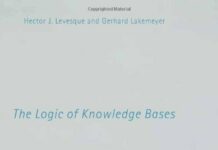
Ebook Info
- Published: 2012
- Number of pages: 322 pages
- Format: PDF
- File Size: 1.81 MB
- Authors: Hector J. Levesque
Description
Students explore the idea that thinking is a form of computation by learning to write simple computer programs for tasks that require thought. This book guides students through an exploration of the idea that thinking might be understood as a form of computation. Students make the connection between thinking and computing by learning to write computer programs for a variety of tasks that require thought, including solving puzzles, understanding natural language, recognizing objects in visual scenes, planning courses of action, and playing strategic games. The material is presented with minimal technicalities and is accessible to undergraduate students with no specialized knowledge or technical background beyond high school mathematics. Students use Prolog (without having to learn algorithms: “Prolog without tears!”), learning to express what they need as a Prolog program and letting Prolog search for answers.After an introduction to the basic concepts, Thinking as Computation offers three chapters on Prolog, covering back-chaining, programs and queries, and how to write the sorts of Prolog programs used in the book. The book follows this with case studies of tasks that appear to require thought, then looks beyond Prolog to consider learning, explaining, and propositional reasoning. Most of the chapters conclude with short bibliographic notes and exercises. The book is based on a popular course at the University of Toronto and can be used in a variety of classroom contexts, by students ranging from first-year liberal arts undergraduates to more technically advanced computer science students.
User’s Reviews
Reviews from Amazon users which were colected at the time this book was published on the website:
⭐This book is a life-saver for anybody taking a Knowledge-Base and Prolog related course for the first time. In this book, the author assumes we are a dummy, without assuming we are stupid. He starts with a procedure for thinking in chapter two that prepares you for Prolog and knowledge base before really introducing it. Through sentence examples he proceeds to illustrate conceptually what a knowledge base is, and he does it in a way that anyone can understand. And he doesn’t blow it – he pulls it off!He then goes on to Prolog, but you aren’t just learning Prolog, you are learning it in context to solving programs. If you are taking any class involving knowledge bases, first-order logic, or prolog, I highly recommend this book. I am using it as a supplement to the higher-level knowledge representation textbook he coauthored. In that book it is strap on your seatbelt and have Google handy to translate the topics you should already know. Not so with this book. After reading chapters one and two, I felt like I had a conceptual underpinning to his harder textbook. Yeah, I still had to go search out supplemental first-order logic symbolic tutorials to understand his text…but those resources were for the formal symbolic stuff. This book is for the concepts behind it. It’s a great book. The author being able to make such a complex topic seem so easy is commendable. Five Stars for this book – it’s a life saver. If you want to truly understand the underpinnings of AI and Knowledge…buy this book. It makes the hard stuff easier, as you can only struggle with the hard stuff and not the concepts behind the hard stuff.
⭐What a great book! I am an IT professional with 20 years of experience. I do not get to write code at work anymore so I code as a hobby. I like to write programs to solve puzzles such as Einstein riddle. I remember sweating for a few weeks writing a solution in Java. In prolog it is just a few lines and the book actually uses it as an example. I have read this book cover to cover and did most of the exercises. I am now preparing to apply what I have learned at work.
⭐This book is an elementary undergraduate introduction to the basics of artificial intelligence. It does not require background in formal logic, mathematics or programming that more advanced books. It moves slowly through the material trying to insure that the reader has mastered one concept before moving onto the next. While I would opt, at times, for an alternative Prolog format, I assume that the authors pedagogical experience formed their choices.This is a textbook at succeeds in teaching what it set out to teach – not exciting but effective.
⭐Perfect book to know the power of AI without delving much into complexity
⭐Nice and quick introduction to artificial intelligence through Prolog. Contains some interesting problems to get you thinking as well as a good theoretical background for considering possibilities, applications, and implementations of AI.
⭐This is an excellent book, well written and easy to understand. The Prolog examples are helpful. I intend to use it as a reference self study book for students getting into AI.
Keywords
Free Download Thinking as Computation: A First Course in PDF format
Thinking as Computation: A First Course PDF Free Download
Download Thinking as Computation: A First Course 2012 PDF Free
Thinking as Computation: A First Course 2012 PDF Free Download
Download Thinking as Computation: A First Course PDF
Free Download Ebook Thinking as Computation: A First Course
